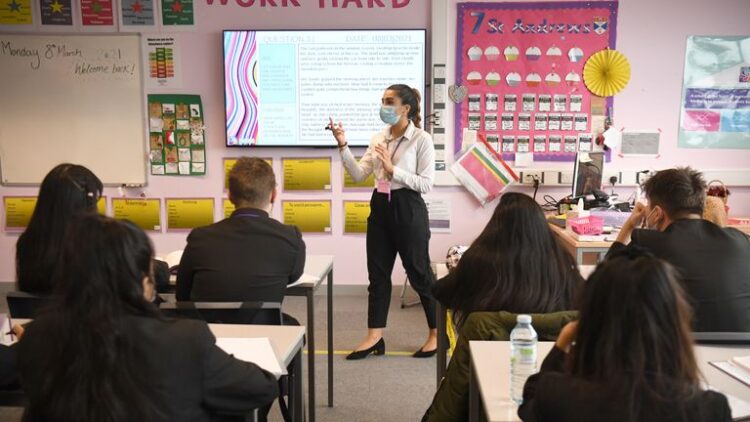By Victoria Mckeown-
The number of pupils absent from school because of Covid has increased by 60 per cent in the past two weeks, according to new figures .
Attendance survey data from the Department for Education estimates that 208,000 state school pupils, or 2.6 per cent of the total population, were absent for Covid-related reasons on November 25, up from 130,000, or 1.6 per cent. Extra caution in schools due to concerns about covid-19 has led school pupils to be absent from school to isolate as a result of them being infected or having contact with someone who is infected.
In many cases, parents are withdrawing their children from some schools because of fears they may contract the virus.
The news comes after the government told secondary schools to reintroduce face coverings in communal areas, as the country deals with the threat from the new Omicron variant of Covid.
Covid-related absence levels had fallen after the half term break in October, but started rising again after pupils returned to school.
Of those absent due to Covid, 106,000 pupils, or 1.3 per cent, were off with a confirmed case of the virus, up from 67,000, or 0.8 per cent, a fortnight before.
Over the same period, the number of pupils off with a suspected case of Covid increased from 50,000 (0.6 per cent) to 79,000 (1 per cent).
A further 10,000 pupils were absent last week due to attendance restrictions put in place to manage an outbreak, up from 4,000 on November 11. And 12,000 pupils were absent due to isolation for other reasons, up from 9,000.
Around 1,000 pupils were also absent because of Covid-related school closures, up from less than 500.Paul Whiteman, general secretary of the NAHT school leaders’ union, said the figures showed the “reprieve” after half term had been “short-lived”.
He pointed to “significant concern” about the impact of the new Omicron variant, and urged the government to act “cautiously early on than to come anywhere close to a position where schools are forced to close again”.
“More needs to be done to safeguard primary and special schools – at the moment they seem to be being entirely overlooked by government.
“And more support needs to be given to all schools to help with ventilation, testing, close contact tracing, and staff cover. We would urge the government to take every safety measure possible while maintaining face-to-face education, in order to avoid longer-term school closures.”
Overall school attendance fell from 89.5 per cent to 87.5 per cent at secondary level, and from 93.6 per cent to 91.1 per cent at primary.
The latest Office for National Statistics infection survey estimates that 3.7 per cent of primary age pupils and 3.5 per cent of secondary age pupils tested positive in the week to November 20.
The secondary age infection rate had dropped from a high of almost 10 per cent in the week before half term. Primary age infection levels have remained fairly stable since early October.
However, more recent data will not be published until the end of this week.
Monday’s attendance da rise in workforce absence due to Covid.
On November 25, 2 perta revealed a rise in workforce absence due to covid related concerns. cent of teachers and leaders and 1.9 per cent of teaching assistants and other staff were absent due to Covid-related reasons, up from 1.4 per cent a fortnight before.
Absence with a confirmed case of Covid was the most common reason for staff being off.
In the absence of routine teaching staff, teaching assistants are generally used to support students, but are generally not expected to be as efficient as the main teacher for particular subjects, given their long experience and training, as well as knowledge of individual students and their needs.
Missing school impacts children from disadvantaged backgrounds most, as few of their parents make alternative arrangements to maintain or improve their academic development.




